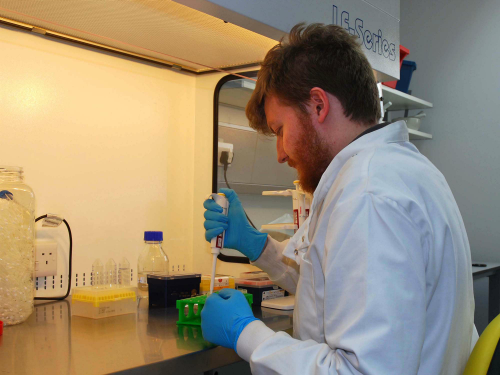The Bristol Palaeobiology Research Group has several laboratories for specialist work in micropalaeontology, acid digestion, and physical preparation of fossils in the Inner Court Building, and for computed tomography, genomics, and biological preparation in the Life Sciences Building.
Palaeobiology Labs
Imaging Lab
Our Imaging Lab provides 12 high-spec workstations for users working with large tomographic datasets (eg synchrotron & micro-CT data) and a range of software packages for 3D visualisation and analysis.
The workstations are often used by students and researchers to examine fossil and extant biological datasets in 3D. Raw tomographic image data are ‘segmented’ to extract regions of interest and generate 3D models.
For segmentation, we maintain several licenses for Thermo Fisher’s Avizo software, while also making use of ImageJ & SPIERS freeware. For Finite Element Analysis we maintain Hyperworks, Abaqus, & Simpleware software licenses. A number of other packages (Blender, Autodesk) are also installed, for example to aid 3D mesh generation.
Molecular Palaeobiology
A distinct laboratory for molecular techniques including DNA/RNA extraction, library construction protocols.
Separate isolated lab areas for tissue extraction and PCR Prep are available.
Facilities include:
- thermal cycler
- UV imager and recorder
- electrophoresis suite
- refrigeration
- shaker incubators
- microfuges
- centrifuges
- water baths
- heatblocks
- autoclave
- -70oC freezer
Fossil preparation
We have a dedicated fossil preparation laboratory in Inner Court, as well as general purpose lab areas sometimes used for microfossil extraction (acid digestion).
Facilities include:
- dust extracted cabinets for air-scribes & air-abrasive mechanical preparation tools
- acid digestion to recover calcium phosphate, silicate, and organic-walled microfossils
- materials for consolidation of fossil bones
- spaces for microfossil processing (picking)
- spaces for microscopy (including camera microscopes & z-stacking)
Wet lab facilities
We also have lab areas with facilities for techniques and protocols including:
- histology
- anatomy
- specimen preparation
- experimental strain recording
- equipment for strain gauge experiments
- decay experiments
- resin embedding
- sample preparation for microscopy
The group also has access to a dedicated Earth Sciences polishing laboratory as well as to the Scanning Electron Microscope and Electron Probe Microanalyser facilities available to all in the department.
Further information
For further information or enquiries, email the Palaeobiology Lab Manager Liz Martin-Silverstone at liz.martin@bristol.ac.uk


